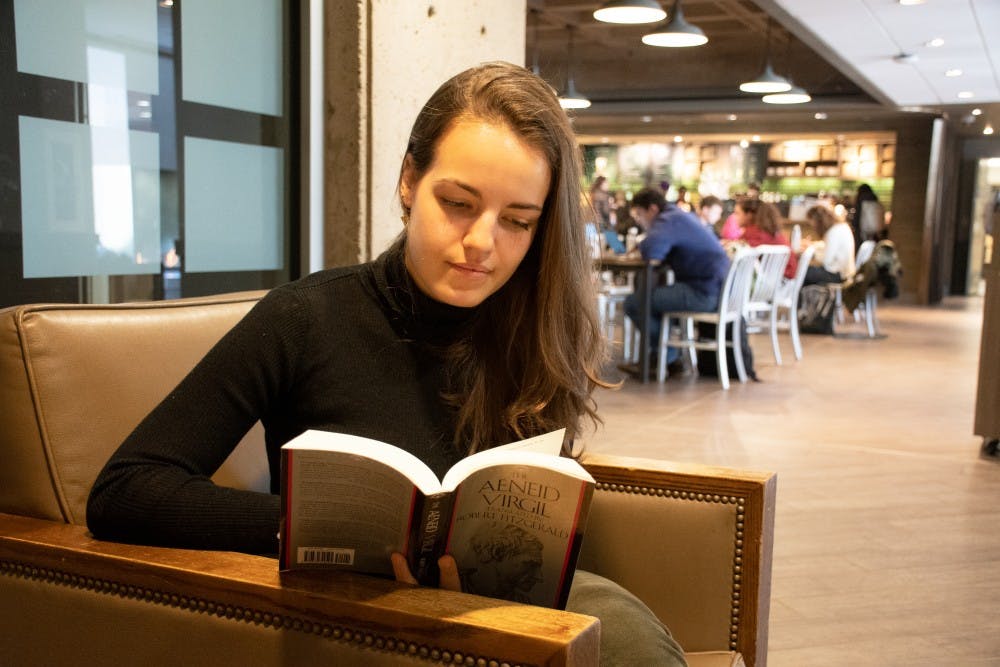
College junior Claire Huffman is currently in “Ancient Epic Poetry”.
Credit: Mariri Niino
In a new classics course, students from Penn and from Yale-NUS College in Singapore have the chance to study epic poetry together and visit each others’ home countries.
“Ancient Epic Poetry” is a collaboration between Penn Classical Studies Department Chair Peter Struck and Yale-NUS literature professor Mira Seo. Struck teaches a group of 10 Penn students, and Seo teaches an identical curriculum to nine Yale-NUS students. Students in the class learn about classic epics from the West, such as “The Iliad” and “The Odyssey,” and epics from the East, including “Gilgamesh” and “Ramayana.”
“Peter Struck and Mira Seo take discussions in different directions,” College junior Eleanor Wynn said. “It’s dynamic, which is good.”
The two groups of students had a chance to visit each others’ campuses back to back over their respective spring breaks. Many said this was the highlight of the course.
The Singaporean students arrived in Philadelphia on Feb. 23. For many of them, it was their first time in the U.S. The group visited tourist attractions such as the Philadelphia Museum of Art, Penn Museum, the Constitution Center, and Reading Terminal Market. Carson Huang, a junior at Yale-NUS, said he especially enjoyed being able to walk around Philadelphia without the heat and looking at archeological finds related to the Gilgamesh.
Arriving in Singapore on March 4, the Penn students participated in classes, visited museums, and enjoyed local cuisine. College junior Maggie Danaher said some of her most memorable moments were learning about the Ramayana dance and Wayang Kulit, traditional Javanese shadow puppetry.

Photo from Carson Huang global seminar ancient epic poetry Singapore
College junior Claire Huffman said the visit to Singapore gave her a new perspective on epic poetry, as she found it interesting to “be with people who would recognize statues of characters from Ramayana just as much as I would recognize Achilles.”
Beyond these trips, the two groups of students communicate throughout the semester through GroupMe and posts on a shared blog. Huffman said the Penn and Yale-NUS sections once tried to hold class together over Skype, but the 12-hour time difference made this difficult.
Students agreed that the course gave them a broader understanding of classics.
“As a classist, it really opened my mind to a more comparative lens,” Danaher said. “It extended what classics are for me — a lot of the times the focus is on Greece and Rome. Bringing in different epics opened up room for more discussions.”
Struck said this comparative approach fits with trends in the field of classical studies.
“We are at a point where we are realizing the importance of understanding the particular antiquity — Greece and Rome — alongside a wider global lens of antiquity,” he added.

Students said they appreciated the chance to meet their peers from Singapore as the two groups of students visited each others’ campuses back to back over their respective spring breaks. (Photo from Carson Huang)
“I think global classics is a great idea,” Huang said. “We at NUS had been naturalized to compare western epics to eastern epics, so we don’t think of it as a very strange concept.”
Students said they appreciated learning alongside people from different backgrounds.
“It was really nice making friends from literally across the world — about as far as you can get,” Danaher said. “That’s a pretty rare opportunity.”